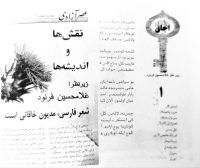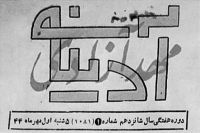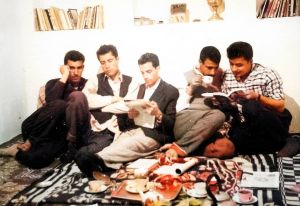Difference between revisions of "Gholam-Hossein Farnoud"
M.aghazadeh (talk | contribs) |
M.aghazadeh (talk | contribs) (Marked this version for translation) Tag: Reverted |
||
| Line 53: | Line 53: | ||
</span> | </span> | ||
<span style="font-family: arial, helvetica, sans-serif;">He began teaching elementary school at </span>[[wikipedia:Mamqan|Mamaqan]]<span style="font-family: arial, helvetica, sans-serif;">, and later at </span>[[wikipedia:Azarshahr|Azarshahr]]<span style="font-family: arial, helvetica, sans-serif;"> Onsori Elementary School, before joining Sa'di High School to teach </span>[[wikipedia:Arabic|Arabic]]<span style="font-family: arial, helvetica, sans-serif;">, </span>[[wikipedia:Fiqh|jurisprudence]]<span style="font-family: arial, helvetica, sans-serif;">, and social sciences. Upon entering the university in 1961, he studied bachelor of English Language and Literature and graduated in 1965. </span>[https://ishiq.net/x%C9%99b%C9%99r/25092/%D8%B4%D9%85%D8%A7%D8%B1%D9%87%E2%80%8C%DB%8C-%D8%AC%D8%AF%DB%8C%D8%AF-%D9%81%D8%B5%D9%84%D9%86%D8%A7%D9%85%D9%87%E2%80%8C%DB%8C-%D8%AA%D8%B1%DA%A9%DB%8C-%D9%81%D8%A7%D8%B1%D8%B3%DB%8C-%D8%A2-8.html [1]]</div> | <span style="font-family: arial, helvetica, sans-serif;">He began teaching elementary school at </span>[[wikipedia:Mamqan|Mamaqan]]<span style="font-family: arial, helvetica, sans-serif;">, and later at </span>[[wikipedia:Azarshahr|Azarshahr]]<span style="font-family: arial, helvetica, sans-serif;"> Onsori Elementary School, before joining Sa'di High School to teach </span>[[wikipedia:Arabic|Arabic]]<span style="font-family: arial, helvetica, sans-serif;">, </span>[[wikipedia:Fiqh|jurisprudence]]<span style="font-family: arial, helvetica, sans-serif;">, and social sciences. Upon entering the university in 1961, he studied bachelor of English Language and Literature and graduated in 1965. </span>[https://ishiq.net/x%C9%99b%C9%99r/25092/%D8%B4%D9%85%D8%A7%D8%B1%D9%87%E2%80%8C%DB%8C-%D8%AC%D8%AF%DB%8C%D8%AF-%D9%81%D8%B5%D9%84%D9%86%D8%A7%D9%85%D9%87%E2%80%8C%DB%8C-%D8%AA%D8%B1%DA%A9%DB%8C-%D9%81%D8%A7%D8%B1%D8%B3%DB%8C-%D8%A2-8.html [1]]</div> | ||
=== <span style="font-family: arial, helvetica, sans-serif;">''The birth of Adineh (1965-1967)''</span> === | === <span style="font-family: arial, helvetica, sans-serif;">''The birth of Adineh (1965-1967)''</span> === <!--T:45--> | ||
<span style="font-family: arial, helvetica, sans-serif;">''In 1964, he was appointed managing editor of "Nagshha va Andisheha" (Persian: نقش ها و اندیشه ها), which was published in the Mahd Azadi newspaper (Persian: روزنامه مهد آزادی) . Nagsha va Andisheha became the catalyst for the rapt attention of his closest friends''</span>[[wikipedia:Samad_Behrangi|Samad Behrangi]] | <span style="font-family: arial, helvetica, sans-serif;">''In 1964, he was appointed managing editor of "Nagshha va Andisheha" (Persian: نقش ها و اندیشه ها), which was published in the Mahd Azadi newspaper (Persian: روزنامه مهد آزادی) . Nagsha va Andisheha became the catalyst for the rapt attention of his closest friends''</span>[[wikipedia:Samad_Behrangi|Samad Behrangi]] | ||
<span style="font-family: arial, helvetica, sans-serif;">'', Rahim Raisnia, and Abdol-Hossein Nahidiazar, and others over a year, which led to the request of chief editor of newspaper Seyyed Javad Peyman from Gholam-Hossein Farnoud for the expansion of writers and articles for publication in weekly eight pages in Mahdeh Azadi newspaper. One day after that, he discussed the matter first with Samad Behrangi and later with Ebrahim Azimpur and other friends, all of whom agreed. This title was chosen with the suggestion of Behruz Dehghani, and they all agreed on the title and the day of publication on each Saturday. The first leading article was written by Gholam-Hossein Farnoud and the following leading articles were authored by other authors at random, each accompanied by the name of the chef editor. Number 17 was the last publication of Adineh, which was confiscated by Savak in 1967.[https://www.gisoom.com/book/11740581/%DA%A9%D8%AA%D8%A7%D8%A8-%D8%A7%D9%86%D8%AF%DB%8C%D8%B4%D9%87-%D9%88%D8%B1%D8%B2-%D8%B1%D9%87%D9%86%D9%85%D8%A7-%D8%A8%D9%87-%DB%8C%D8%A7%D8%AF-%D8%BA%D9%84%D8%A7%D9%85%D8%AD%D8%B3%DB%8C%D9%86-%D9%81%D8%B1%D9%86%D9%88%D8%AF/ [2]]''</span> | <span style="font-family: arial, helvetica, sans-serif;">'', Rahim Raisnia, and Abdol-Hossein Nahidiazar, and others over a year, which led to the request of chief editor of newspaper Seyyed Javad Peyman from Gholam-Hossein Farnoud for the expansion of writers and articles for publication in weekly eight pages in Mahdeh Azadi newspaper. One day after that, he discussed the matter first with Samad Behrangi and later with Ebrahim Azimpur and other friends, all of whom agreed. This title was chosen with the suggestion of Behruz Dehghani, and they all agreed on the title and the day of publication on each Saturday. The first leading article was written by Gholam-Hossein Farnoud and the following leading articles were authored by other authors at random, each accompanied by the name of the chef editor. Number 17 was the last publication of Adineh, which was confiscated by Savak in 1967.[https://www.gisoom.com/book/11740581/%DA%A9%D8%AA%D8%A7%D8%A8-%D8%A7%D9%86%D8%AF%DB%8C%D8%B4%D9%87-%D9%88%D8%B1%D8%B2-%D8%B1%D9%87%D9%86%D9%85%D8%A7-%D8%A8%D9%87-%DB%8C%D8%A7%D8%AF-%D8%BA%D9%84%D8%A7%D9%85%D8%AD%D8%B3%DB%8C%D9%86-%D9%81%D8%B1%D9%86%D9%88%D8%AF/ [2]]''</span> | ||
Revision as of 19:23, 26 July 2022
Gholam-Hossein Farnoud Zhendeh (Turkish (Az) or Azerbaijani-Turkish: Qulamhüseyin Fərnud Jende; تورکجه، فارسی: غلامحسین فرنود ژنده ; Turkish (Tr) or Turkey Turkish: Gulamhüseyn Fernud Jende; February 24,1941 in Tabriz - March 15, 2020 in Tabriz) was a prominent South Azerbaijani or Iranian-Azerbaijani publicist, author, critic, translator, University lecturer and social/cultural activist. In 1964, he was appointed managing editor of "Nagsha va Andisheha" (Persian: نقش ها و اندیشه ها), which was published in the Mahd Azadi newspaper (Persian: روزنامه مهد آزادی) and was the catalyst for the rapt attention of his close friends Samad Behrangi, Rahim Raisnia, and Abdol-Hossein Nahidiazar. After a year, with request of chief editor of newspaper Seyyed Javad Peyman from Gholam-Hossein Farnoud, they decided to publish the "Adineh" with inviting more authors. As result, the several articles by famous South Azerbaijani authors Samad Behrangi, Gholam-Hossein Saedi, Reza Baraheni, Alireza Nabdel, Maftun Amini, Hassan Ruzpeykar, Behruz Dehgani, Rahim Raisnia and some other Azerbaijani and Iranian authors were published weekly over two years in 8 pages. Adineh has important role in aggregation of South Azerbaijani and other Iranian mostly left-wings believed intellectuals against Pahlavi regime until it was confiscated by Savak in 1967. [1] [2]
. .
| Born | 24 February 1941 Tabriz
|
|---|---|
| Died | 15 March 2020 Tabriz
|
| Cause of death | cardiac arrest |
| Nationality | South-Azerbaijani |
| Citizenship | Iran |
| Education | Master of English Language and Literature, PhD of Social Sciences |
| Alma mater | Daneshsara Tabriz (University of Azerbaijan), University of Istanbul |
| Occupation | Author, Social/Cultural activist, Critic, Chef Editor, Teacher and University Lecturer |
| Years active | 1960-2020 |
Notable work
|
Adineh (Mahd Azadi Newspaper), Dar Basateh Noktedanan |
| Spouse | Mehrangiz Mahmoud Shariati |
| Children | Saba Farnoud (Daughter) and Taher Farnoud (Son) |
| Relatives | Aria E. Torkanbouri (son in-law) |
| Signature | |
== Biography == === Early life ===
Having completed his primary education at Sa'di, Roshdiye, Sasan, and Hemam Tabriz elementary schools, he completed his secondary education at Khaghani, Ferdowsi, Mansoor (presently Taleghani) middle schools, and Daneshsarayeh Tabriz (Also known as University of Azerbaijan) (1958-1960).
He began teaching elementary school at Mamaqan, and later at Azarshahr Onsori Elementary School, before joining Sa'di High School to teach Arabic, jurisprudence, and social sciences. Upon entering the university in 1961, he studied bachelor of English Language and Literature and graduated in 1965. [1]The birth of Adineh (1965-1967)
In 1964, he was appointed managing editor of "Nagshha va Andisheha" (Persian: نقش ها و اندیشه ها), which was published in the Mahd Azadi newspaper (Persian: روزنامه مهد آزادی) . Nagsha va Andisheha became the catalyst for the rapt attention of his closest friendsSamad Behrangi , Rahim Raisnia, and Abdol-Hossein Nahidiazar, and others over a year, which led to the request of chief editor of newspaper Seyyed Javad Peyman from Gholam-Hossein Farnoud for the expansion of writers and articles for publication in weekly eight pages in Mahdeh Azadi newspaper. One day after that, he discussed the matter first with Samad Behrangi and later with Ebrahim Azimpur and other friends, all of whom agreed. This title was chosen with the suggestion of Behruz Dehghani, and they all agreed on the title and the day of publication on each Saturday. The first leading article was written by Gholam-Hossein Farnoud and the following leading articles were authored by other authors at random, each accompanied by the name of the chef editor. Number 17 was the last publication of Adineh, which was confiscated by Savak in 1967.[2]
Death of Samad Behrangi and years of imprisonment (1968-1974)
A few years after the confiscation of the Adineh, he published a selection of prose and stories under the title The Stroy of Mother (Persian: سرگذشت مادر) and a translation from poets and the Life ofT.S. Eliot . Additionally, he collaborated with his friends Behruz Dehghani and Mehdi Amini in translating "Can Science Save Us?" (Persian: آیا علم می تواند ما را نجات دهد؟). Later in his career he was editor and Managing Director of Ibn Sina Press, where he published two books, "Do Mobarez" (Persian: دو مبارز) and "Balvayeh Tabriz" (Persian: بلوای تبریز), and several selections from the works of Obayd Zakaniwith an introduction byAnatoly Lunacharsky. Aside from that, he was also a supervisor of Samad Behrangi's book "Investigations into the Educational Problems of Iran" (Persian: کندوکاو در مسائل تربیتی ایران) and his storybook for children "Olduz and the Crows" (Persian: اولدوز و کلاغها). Arranging some shows at Mamaqan schools to provide books to schools as well as translating and publishing "Racism: An Ideological Weapon of Imperialism" (Persian: نژادپرستی و جهانخواری) by Fedor Mikhaĭlovich Leonidov with the approval and encouragement of Samad Behrangi were some of his other activities. [1]
On 30 August 1968, Samad Behrangi drowned in Araz River. Aside from the strong effect of his death on his close friends, it also had a significant effect on South Azerbaijan and Iran's societies, serving as a powerful catalyst for the anti-Pahlavi revolution. After a year, Gholam-Hossein Farnoud qualified for the entrance examination to theSocial SciencesPhD program at theUniversity of Istanbul. During the two years he worked on his thesis, he was arrested on the way to Istanbul alongside friends Behruz Dehgani, Kazem Saadati, Ashraf Dehgani, Alireza Nabdel, etc. [1]. Kazem Saadati committed suicide before being arrested by the police to inform his friends [6][7]. Behruz Dehghani died of torture inside the jail [8]. Alireza Nabdel repeatedly attempted suicide in jail, but finally, he was executed by Pahlavi regime [9][10].Ashraf Dehganisuccessfully escaped from jail and migrated to Germany [11].
=== Years after imprisonment until the revolution (1974-1979) ===
After being released from prison in 1973, Gholam-Hossein Farnoud was hired by Tabriz Radio as a producer. Also, he continued translating, authoring and publishing books. Translation of "Sevdalı Bulut" (Persian: ابر دلباخته) of Turkish poet Nazım Hikmet with Ali Katebi, publishing the books "Grandchildren and great-grandchildren of Mollanasreddin" (Persian: نوه نتیجه های ملانصرالدین) about the biography of Turkish caricaturists, the manuscript of "Naseri Events" (Persian: وقایع ناصری) about the unpublished documents of Constitutional Revolution with using pseudonym Ali Siyahpush, and translation of "About the new centuries"(Persian: سیری کوتاه در قرون جدید), "Fascism and Antonio Gramsci" (Persian: فاشیسم و آنتونیو گرامسی) and "The Cultural Revolution in Cuba" (Persian: انقلاب فرهنگی در کوبا) were some of his activities in that way. Additionally, he managed the Ehya Press (Persian: نشر احیا) which published historical, scientific, and literary books. "Ark Periodical" (Persian: گاهنامه ارک) was one of his last books, published with delay, on the eve of the revolution, as a result of the applied filters during the Pahlavi period. [1] Apart from his activities as an editor, author, and publisher, he was also active in cultural events. He supported a variety of artists including painter and caricaturist Kayumars Kiasat , sculptor Behruz Heschmat, and Ashiq Hassan Eskandari, among others. [1][2]
=== After Revolution of Iran (1979-2013) ===

During 1981, he married Mehrangiz Mahmoud Shariati. Two of their children are Taher Farnoud (1983) and Saba Farnoud (1990). Gholam-Hossein Farnoud always described himself as a 'normal teacher', and he was active primarily as a social and cultural activist, holding left-wing political views, but he was not a political activist. The fact remains that he had close relationships with people like Samad Behrangi, who became a symbol of the left-wing movements of the new generation of South Azerbaijani believers after his death, and with other friends who later joined Iranian People's Fedai Guerrillas were sufficient grounds for his arrest during the pre-revolutionary period. In spite of this, the situation for him and his friends did not significantly improve following the revolution. A poignant example of the tragedy committed against left-wing activists can be found in the Chain Murders of Iran (1988-98). However, he did not stop in his efforts to increase awareness of people and society. Among his significant activities following the revolution are the production of Ark Periodical's second number, the translation of Chingiz Aitmatov's "Camel's Eye" with the pseudonym Taher Danesh, the simplification of Don Quixote by Miguel de Cervantes, and the translation of "The People of the Abyss" by Jack London with pseudonym Abolfazl Atrak. [1] Additionally, he worked as a lecturer at various universities in English, aesthetics, child art, allegory, sociology of art, etc. at the Vocational school of Tabriz, the Islamic Azad University of Tabriz, Iranian Youth Cinema Society Tabriz , and the University College of Nabi Akram Tabriz. Apart from this, he has served as chief editor of the Kar va Niru newspaper, the second 17-series of Adineh by Mahd Azadi newspaper, and Akhtar newspaper.
==== After death of Mehrangiz Mahmoud Shariati (2013-2020) ====
Mehrangiz Mahmoud Shariati died of splenic cancer on 15 November 2013. The funeral was attended by a large crowd. Mehrangiz's will and Gholam-Hossein's decision resulted in the funeral taking place without any routine rituals and the entire cost of the event was used to purchase a comfortable chair for Tabriz Cancer Hospital. In the period between 2013-2018, he has concentrated on revealing portions of events and documents he had carefully guarded for many years. He published a few of them including talking about Adine's birth, a manuscript of a poem by Samad Behrangi, some memories about Samad Behrangi and a few other things, all of which were publicly shared in video form recorded by his son Taher Farnoud form via social media until 2018. "Ever Teacher" (تورکجه، فارسی:همیشه معلم) is the title given to her by Gholam-Hossein. Every anniversary, a book was published in memory of Mehrangiz Shariati by him. Among them are "Baz Khaham Shekoft" by Saideh Paknejad and "Ruzeh avvaleh Moallemi" by Hassan Kafi. However, he temporarily stopped the commemoration ceremony process due to some family reasons, while seeking to publish the following text at 11 November 2018 (see below):

The year after 2019, deu to some changes inside family, he started to arranged and distributed all material and spiritual assets among his children equally and without discrimination based on gender in accordance with his wife's will as well as his own.
=== Death ===
During the early hours of 15 March 2020, his brother Reza Farnoud discovered him dead at his home in Tabriz, South-Azerbaijan/Iran. A cardiac arrest was detected as the cause of death. As a result of the Corona quarantine rules and traveling restrictions, only Taher Farnoud and his wife have commuted to Gholam-Hossein's home and had access to his valuable original manuscripts, historical documents, recordings and paintings. There is only one published manuscript from him to date, which was the very short text about the burial place and funeral, which was written for his son Taher Farnoud, daughter Saba Farnoud, and son-in-law Aria E. Torkanbouri in 2015. == Literary works == Books
- Naseri Events (1977)
- About the new centuries (1978)
- Duman (2002)
- Dar Basateh Noktedanan (2011)
'Translations
- Can Science Save Us (1969)
- Racism: An Ideological Weapon of Imperialism, Fedor Mikhaĭlovich Leonidov (1969)
- Dar haghe Chand Pishtaz, Eduardo Sanguine T, Andrea Moroa, Aram Khachaturian, Anatoly Lunacharsky (1976)
- Grandchildren and great-grandchildren of Mollanasreddin" (1977) (pseudonym Ali Siyahpush)
- Setayesh va Sangsar, T. S. Eliot (1977)
- Fascism and Antonio Gramsci (?)
- The Cultural Revolution in Cuba (1980) (pseudonym Ali Siyahpush)
- The People of the Abyss", Jack London (1983) (pseudonym Abolfazl Atrak)
- Don Quixote, Miguel de Cervantes (1989) (pseudonym Abolfazl Atrak)
- Camel's Eye, Chingiz Aitmatov (2014) (pseudonym Taher Danesh)
Children's Books
- Sevdalı Bulut, Nazim Hikmet (1972)
- The fox and the thrush, Aleksey Nikolayevich Tolstoy (1977)
Others
- Nagshha va Andisheha (1964)
- Adine I (1965-1967)
- Ark Periodical I (1978)
- Ark Periodical II (1981)
- Adine II (1997)
- Adine III (2000-2002)
References
- Farnoud, Gholam-Hossein and others. (2020). "Gholam-Hossein Farnoud: A thoughtful seeker, in the ways of knowledge", in Azeri: International Turkish - Persian, Cultural, Social, Literary and Art Quarterly, numbers 43&44: 1-95
- Torkan, Qasem and others. (2020). "Andishevarze Rahnoma: in memory of Gholam-Hossein Farnoud". Tabriz: Mahdeh Azadi Press.
- IBNA news agency. (2020). "Gholam Hossein Farnood died in the last days of the year". 15th March.
- Ishiq website. (2013). "A memorial service for Ms. Mehri Shariati will be held on Thursday".









